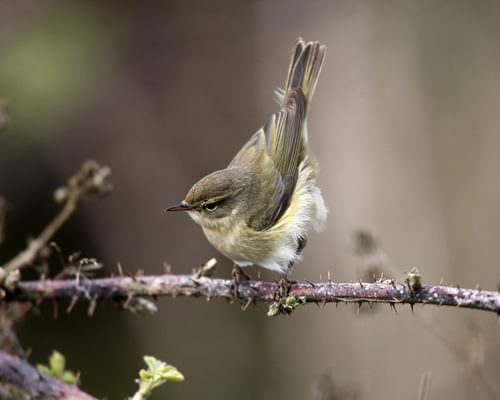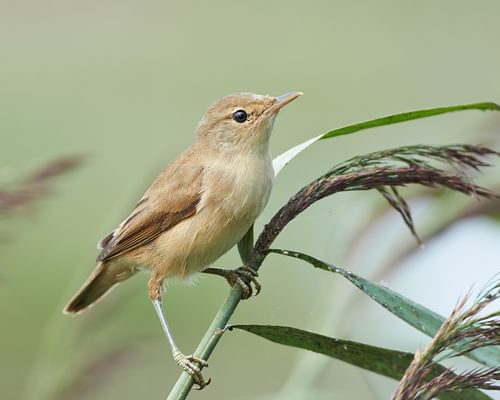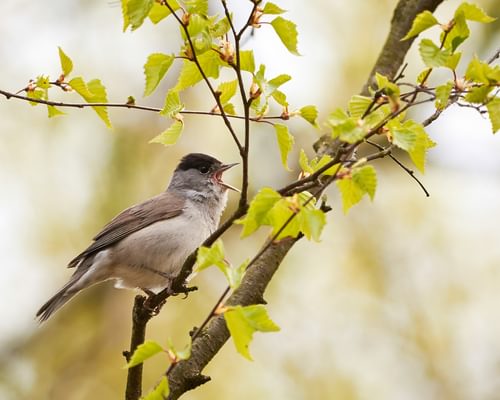Garden Warbler
Sylvia borin
Visual Identification
Appearance
The Garden Warbler is a small, plain songbird with an overall dull brown-grey plumage. It has a slightly paler underside and a faint pale eye-ring, which can be difficult to see in the field. The bird lacks any distinctive markings or patterns.
Males and females are virtually identical in appearance. Juveniles closely resemble adults but may have a slightly warmer brown tone to their plumage. There are no significant seasonal plumage changes in this species.
Size
Length
14cm to 15cm
Wingspan
22cm to 24cm
Weight
16g to 22g
Colours
Males and females have similar plumage
Primary Colour
Brown Grey
Secondary Colour
Buff White
Beak Colour
Grey
Leg Colour
Grey
Habitat and Distribution
Habitats
Woodland
Garden
Wetland
Coastal
Urban
Farmland
Grassland
Desert
Tundra
Rainforest
Mountain
Savanna
Distribution
Garden Warblers breed across much of Europe and western Asia, favouring deciduous woodlands, forest edges, and dense scrubland. They also inhabit parks and mature gardens with sufficient cover. They are widespread but patchily distributed in the UK, being more common in southern and eastern regions.
During winter, these birds migrate to sub-Saharan Africa, occupying a range of wooded and scrub habitats. Their distribution spans from Senegal east to Ethiopia and south to South Africa, showcasing their remarkable long-distance migration capabilities.
Elevation Range
Up to 2,300 meters
Climate zones
Temperate, Subtropical
Distribution Map
This map gives you a rough idea of where you might spot a Garden Warbler. The coloured areas show countries where these birds have been seen.
A few things to keep in mind:
- Birds might not be everywhere in the coloured areas, for example, they may be present around the coast of that country
- Where birds live can change with seasons and available food
- This map is quite simple - it doesn't show exact locations
We're working on making our maps even better! Soon, we hope to show you:
- More detailed maps for bigger countries, including state and region
- How birds move around during different seasons
Distribution by Region
Behaviour and Ecology
Bird Attributes
This feature is in beta. We'd love your feedback to improve it!
Share your thoughtsBird Attributes Explained
Our bird attributes system rates various aspects of a bird's capabilities on a scale of 0-100, based on data from field observations, scientific studies, and expert knowledge.
Attribute Categories:
- Agility: Manoeuvrability, speed, and grace in flight or movement.
- Strength: Physical power, often correlating with size and hunting abilities.
- Adaptability: Ability to thrive in various environments or changing conditions.
- Aggressiveness: Territorial behaviour and assertiveness, particularly during breeding seasons.
- Endurance: Stamina, often seen in migration patterns or foraging behaviours.
Understanding the Ratings:
- 0-20: Very Low
- 21-40: Low
- 41-60: Average
- 61-80: High
- 81-100: Very High
Remember, these attributes are relative to other bird species and don't necessarily indicate superiority.
Hover over the icon next to each attribute for more information.
Tap the icon next to each attribute for more information.
Agility
Reflects the bird's manoeuvrability, speed, and grace in flight or movement.
The Garden Warbler demonstrates high agility through its quick, precise movements whilst foraging among leaves and branches. Its ability to navigate dense vegetation and perform intricate manoeuvres during insect capture suggests excellent agility for a small songbird.
Strength
Indicates the bird's physical power, often correlating with size and hunting abilities.
As a small passerine, the Garden Warbler possesses modest strength. Whilst capable of the physical demands of migration, it lacks the powerful musculature of larger or predatory birds. Its size and insectivorous diet indicate relatively low strength compared to many other bird species.
Adaptability
Represents the bird's ability to thrive in various environments or changing conditions.
The Garden Warbler shows remarkable adaptability. It thrives in various habitats from woodlands to gardens, adapts its diet seasonally, and undertakes long-distance migrations. Its ability to significantly increase body weight before migration and survive in diverse African wintering grounds further demonstrates high adaptability.
Aggressiveness
Measures the bird's territorial behaviour and assertiveness, particularly during breeding seasons.
Garden Warblers exhibit moderate aggressiveness. Males defend territories and sing from exposed perches during breeding season, indicating some territorial behaviour. However, they are not known for particularly aggressive interactions with other species or conspecifics outside of normal breeding behaviour.
Endurance
Reflects the bird's stamina, often seen in migration patterns or foraging behaviours.
The Garden Warbler's endurance is exceptionally high. Its ability to undertake long-distance migrations from Europe to sub-Saharan Africa, coupled with the capacity to increase body weight by up to 65% before these journeys, demonstrates remarkable stamina and energy efficiency.
Diet
Garden Warblers are primarily insectivorous during the breeding season, feeding on various insects and their larvae. Aphids, flies, beetles, and caterpillars are all key prey items.
Later in the year, they supplement their diet with berries and small fruits, especially during autumn migration. These birds gorge on elderberries and other soft fruits to build up fat reserves for their long migratory journeys.
Behaviour
Garden Warblers are known for their skulking behaviour, often staying hidden within dense vegetation. They forage actively among leaves and branches, gleaning insects with quick, precise movements.
During the breeding season, males become more visible as they sing from exposed perches to defend territories and attract mates.
Vocalisation
What they lack in distinctive visual appearance, Garden Warblers more than compensate in musical ability.
The song is a rich, melodious warble lasting up to 5 seconds. It consists of a series of sweet, fluty notes that rise and fall in pitch, often described as 'bubbling' or 'liquid'.
Their call is a soft, low 'tack' or 'chek'. During migration, they may give a quiet, scratchy subsong. Some mimicry also occurs.
Nesting & Breeding
Garden Warblers form monogamous pairs each breeding season, typically from May to July in Europe. Males establish territories and attract females with their rich, melodic songs.
The female builds a cup-shaped nest low in dense vegetation, often in brambles or nettles. The nest is constructed of grass stems and leaves lined with finer materials. A clutch of 4-5 eggs is laid, which are creamy-white with brown speckles.
Both parents incubate the eggs for about 11-12 days. The chicks are altricial and fledge after 9-12 days, but the parents continue to feed them for another two weeks. Some pairs may attempt a second brood if conditions are favourable.
Conservation and Status
Global Conservation Status
While the Garden Warbler is currently listed as Least Concern, it faces threats from habitat loss in both breeding and wintering grounds. Climate change may also affect its migration patterns and breeding success.
Conservation efforts focus on preserving diverse woodland habitats and reducing the use of pesticides in agricultural areas.
Birdwatching Tips
- Listen for their melodious, flute-like song in woodland edges and gardens
- Look for movement in dense foliage, especially in the lower to middle levels of vegetation
- Observe feeding behaviour on fruit trees during late summer and early autumn
- In the UK, watch for them in hedgerows and scrubland from April to September
Additional Information
Quick Facts
Predators
Garden Warblers are preyed upon by various birds of prey, including Sparrowhawks and Hobbies. Ground predators such as cats, stoats, and weasels may also target nests and fledglings.
Did You Know?
- Garden Warblers can increase their body weight by up to 65% before migration.
- Despite their name, they are more commonly found in woodlands than gardens.
- They are one of the latest spring migrants to arrive in Europe, often not appearing until May.
Similar Birds
References
- 1 2
website: BirdLife International. 2017. Sylvia borin (amended version of 2016 assessment). The IUCN Red List of Threatened Species 2017: e.T22716906A111812037.
View source - 3
report, 2015: EBCC
Share Your Feedback
We value your opinion! Let us know what you think about this bird page.


